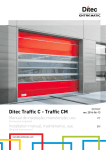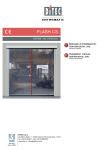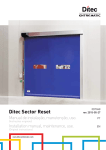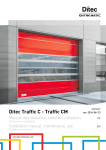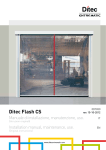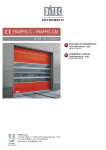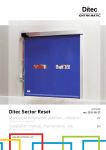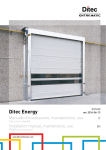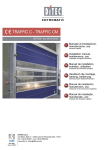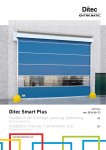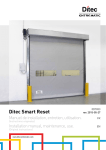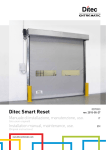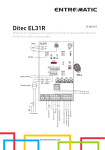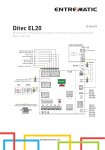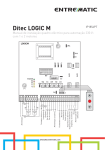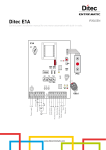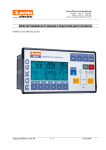Download Ditec Sector
Transcript
0DT827 Ditec Sector rev. 15-10-2012 Manual de instalação, manutenção, uso. PT Installation manual, maintenance, use. EN (Instruções originais) (Original instructions) www.ditecentrematic.com ÍNDICE DOS ASSUNTOS Cap.Assunto ................................................................................................................................. Pág. 1. CARACTERÍSTICAS TÉCNICAS ................................................................................................ 2 2. AVISOS GERAIS PARA A SEGURANÇA ................................................................................... 3 3. INSTALAÇÃO MECÂNICA 3.1 Verificações do vão de passagem........................................................................................... 4 3.2 Fixação das colunas verticais.................................................................................................. 4 3.3 Montagem da travessa ........................................................................................................... 4 3.4 Montagem dos contrapesos ................................................................................................... 4 3.5 Montagem da alavanca de desbloqueio de emergência ........................................................ 4 3.6 Instalação das fotocélulas (quando previstas)......................................................................... 4 3.7 Instalação da borracha de segurança .................................................................................... 4 4. ELÉCTRICAS CABLAGENS 4.1 Quadro eléctrico....................................................................................................................... 5 4.2 Ligações do quadro elétrico / motor / seguranças................................................................... 5 4.3 Fotocélulas de segurança........................................................................................................ 5 5. QUADRO ELECTRÓNICO 5.1 49E - ligações.......................................................................................................................... 6 5.2 47E (inverter) - ligações......................................................................................................... 10 6. REGULAÇÕES E ARRANQUE 6.1 Controle dos sentidos de movimento ................................................................................... 14 6.2 Regulação da borracha com fio............................................................................................. 14 7. LOCALIZAÇÃO DE AVARIAS ................................................................................................... 15 8. PLANO DE MANUTENÇÃO ...................................................................................................... 16 1. AVISOS GERAIS PARA A SEGURANÇA O presente manual de instalação é para o uso exclusivo de pessoal profissionalmente especializado. A instalação, as ligações elétricas e as regulações devem ser efetuadas com o respeito da Boa Técnica e de acordo com as normas vigentes. Ler atentamente as instruções antes de iniciar a instalação do produto. Uma instalação errada pode ser fonte de perigo. Os materiais da embalagem (plástico, isopor, etc.) não devem ser abandonados no ambiente e não devem ser deixados ao alcance de crianças porque são fontes potenciais de perigo. Antes de iniciar a instalação verificar a integridade do produto. Não instalar o produto em ambiente e atmosfera explosivos: presença de gases ou fumos inflamáveis constituem um grave perigo para a segurança. Antes de instalar a porta, efetuar todas as reformas de estrutura relativas à realização dos suportes de segurança e à proteção ou isolamento de todas as zonas de esmagamento, cisalhamento, deslocamento e de perigo em geral. Verificar que a estrutura existente tenha os requisitos necessários de resistência e estabilidade. Os dispositivos de segurança (fotocélulas, partes sensíveis, parada de emergência, etc.) devem ser instalados levando em consideração: as normas e as diretrizes em vigor, os critérios da Boa Técnica, o ambiente de instalação, a lógica de funcionamento do sistemas e as forças desenvolvidas pela porta ou portão motorizados. Os dispositivos de segurança devem proteger eventuais zonas de esmagamento, cisalhamento, deslocamento e de perigo em geral, da porta. Aplicar as sinalizações previstas pelas normas vigentes para marcar as zonas perigosas. Cada instalação deve manter visível a indicação dos dados identificativos da porta. Antes de ligar a alimentação elétrica verificar que os dados da placa sejam correspondentes àqueles da rede de distribuição elétrica. Na rede de alimentação prever um interruptor/disjuntor unipolar com distância de abertura dos contatos igual ou superior a 3 mm. Verificar que a montante da instalação elétrica haja um interruptor diferencial e uma proteção de excesso de corrente adequados. Ligar a porta a uma instalação de aterramento eficaz executada conforme previsto pelas normas de segurança em vigor. O fabricante da porta se exime de qualquer responsabilidade se forem instalados componentes incompatíveis para os fins de segurança e do bom funcionamento. Para a eventual reparação ou substituição dos produtos deverão ser utilizados exclusivamente peças de reposição originais Ditec Entrematic. O instalador deve fornecer todas as informações relativas ao funcionamento automático, manual e de emergência da porta ou portão motorizados, e entregar ao utilizador da instalação as instruções de uso. Acessório opcional C Safety Confort T Safety Top Todos os direitos são reservados Os dados indicados foram redigidos e controlados com o máximo cuidado. Contudo, não podemos assumir qualquer responsabilidade por eventuais erros, omissões ou aproximações devidas a exigências técnicas ou gráficas. 0DT827 15/10/2012 -2- PT 5 1 2 10 4 3 11 20 15 18 19 14 13 12 17 16 8 9 7 6 Rif. 1 2 3 4 5 6 7 8 9 10 Descrição Contentor Tampa do contentor Motor K10AT4 Corrente de transmissão Eixo de enrolamento Patim da borracha de segurança Esteira porta cabos Alavanca manual de desbloqueio Borracha de segurança Correia de contrapeso Rif. 11 12 13 14 15 16 17 18 19 20 Descrição Contrapeso modular Tampa da coluna direita Tampa da coluna esquerda Coluna direita Coluna esquerda Quadro eléctrico Fotocélula LAB4 Perfil em alumínio Sector da estrutura em PVC transparente Sector da estrutura em poliéster 2. CARACTERÍSTICAS TÉCNICAS QUADRO ELECTRÓNICO TRIFÁSICO (49E) QUADRO ELECTRÓNICO 47E (INVERSEUR) Tensão de alimentação....................... 400 V, 50/60 Hz Absorção.................................................................. 4 A Alimentação comandos auxiliares....................24V Potência motor............................................... 0,75 KW Grau de proteção quadro de comando............... IP 55 Temperatura nominal.................................. - 5 + 50 °C Tensão de alimentação.... 230 V monofásica 50/60 Hz Absorção.................................................................. 8 A Alimentação comandos auxiliares....................24V Potência motor............................................... 0,75 KW Grau de proteção quadro de comando............... IP 55 Temperatura nominal.................................. - 5 + 50 °C -3- 0DT827 15/10//2012 3. INSTALAÇÃO MECÂNICA Ver os desenhos relativos à instalação mecânica nas páginas 22 - 23 (folha central a destacar) 3.1 Verificações do vão de passagem (fig.1) • Verificar as dimensões do vão e a correspondência com as medidas totais da porta fornecida, considerando as eventuais tolerâncias necessárias no caso de instalação em luz. • Verificar que eventuais obstáculos existentes não dificultem a montagem da estrutura. • Verificar que os suportes de apoio sejam nivelados e eventualmente restaurá-los mediante calços adequados. • Verificar a consistência da estrutura do vão: deve ser garantida uma ancoragem segura mediante suportes ou buchas. No caso de pouca ou duvidosa consistência é necessário realizar uma estrutura metálica autoportante adequada. 3.2 Fixação das colunas verticais (fig.2) • Medir a dimensão total da travessa (LT). • Marcar no piso a exacta posição dos montantes verticais. • Remover as tampas dos montantes verticais e fixar as bases em correspondência das marcas, por meio de apropriadas buchas de tamanho M8. • Colocar a prumo os montantes verticais e fixá-los em correspondência dos pontos indicados (A) com estribos externos ou (B) para fixação a partir do interior da coluna. Tamanho das buchas M8. • Verificar a ortogonalidade da montagem medindo as diagonais. Não perfurar o montante vertical direito em correspondência da área de deslizamento contrapeso (C). 3.3 Montagem da travessa • Remover as porcas M8 que são pré-montadas nas extremidades da travessa. • Levantar com cuidado a travessa através do carrinho elevador ou outros equipamentos de levantamento, certificando-se de que não caia durante a fase de levantamento, protegendo a estrutura contra eventuais danos (fig.3). • Apoiar a travessa nos montantes verticais, reinserir as porcas de fixação e apertá-las (fig.4). • Em caso de portas com PL > 4000 aconselha-se de fixar centralmente a travessa (para evitar uma flexão anti-estética da carpintaria). 3.4 Montagem dos contrapesos • Desenrolar completamente a correia (deixando apenas 1 giro a mais) enrolada no tambor de enrolamento, fazendo passar a correia na polia intermediária (fig.5). • Fixar a correia com a apropriada chapa (fig.6). Regular o comprimento da correia de modo que a barra roscada permaneça a aprox. 200 mm do chão (com a porta completamente aberta). • Realizar a regulação fim do balanceamento através dos 4 elementos inferiores do contrapeso. 3.5 Montagem da alavanca de desbloqueio de emergência • A alavanca de desbloqueio de emergência deve ser montada na estrutura ou na parede; a uma altura mínima de 1,8 m do chão (fig. 8). • Em caso de montagem na estrutura, utilizar as medidas indicadas na (fig.9) e alojar o cabo de accionamento nos espaços e ligá-los com o travão do moto-redutor (fig.10). • Verificar o correcto funcionamento do dispositivo; agindo na alavanca, a estrutura deve poder se levantar. 3.6 Instalação das fotocélulas • Instalar os contentores no interior das tampas da coluna. Para a instalação e as ligações, utilizar as instruções inseridas na embalagem das fotocélulas. 3.7 Instalação da borracha de segurança • Posicionar a estrutura a cerca de 1 m de altura. • Introduzir a borracha de segurança no bolso inferior da estrutura (fig.11). • Fazer deslizar a borracha ao longo do comprimento da estrutura e centralizá-la perfeitamente em relação à própria estrutura. • Introduzir os patins no perfil de alumínio e fixá-los por meio dos parafusos de auto-roscagem, posicionando-os nos apropriados espaçadores plásticos. • Ligar a extremidade livre da esteira porta cabos ao patim de nylon da borracha de segurança, (fig.12). • Introduzir os patins no perfil de alumínio e fixá-los por meio dos parafusos de auto-roscagem, posicionando-os nos apropriados espaçadores plásticos. • Fixar cada lado da estrutura ao correspondente patim através um parafuso autorroscante (D) (fig.12). 0DT827 15/10/2012 -4- PT 4. ELÉCTRICAS CABLAGENS 4.1 Quadro eléctrico • Introduzir no contentor os cabos com as placas de bornes pré-cabladas e conectá-las às placas (fig.13). Colocar os cabos na calha e conectar os conectores pré-dispostos no motor (fig.14). 4.2 Ligações do quadro eléctrico / motor / seguranças • Na figura 15 estão mostrados esquematicamente os cabos fornecidos e sua posição na porta; cada fiação é marcada com um código colocado sobre uma etiqueta adesiva. 4.3 Fotocélulas de segurança • Executar as ligações presentes na porta conforme indicado na (fig.15). • Executar as ligações no quadro electrónico conforme indicado nos esquemas. 13 14 15 A935G/E 0 1 Preto Azul Tx2 C T Tx1 -5- 0 1 Rx1 Preto Azul Laranja Vermelho Preto Azul Laranja Vermelho Rx2 0 1 Preto Azul 7796 0 1 0DT827 15/10//2012 5.1 QUADRO ELECTRÓNICO 49E - Ligações 49E Entrada Função Comando Descrição 1 2 N.O Fecho automatico O fecho permanente do contacto activa o fecho automático. 1 3 N.O Abertura Com DIP1=ON o fecho do contacto activa a manobra de abertura. Passo-a-passo Com DIP1=OFF o fecho do contacto activa uma manobra de abertura ou fecho em sequência: abre-stop-fecha-abre. N.B.: se o fecho automático é desactivado, o stop não é permanente mas é da duração configurada por TC. 1 4 N.O Fecho O fecho do contacto activa a manobra de fecho. 1 6 N.C Dispositivo de segurança de inversão A abertura do contacto de segurança provoca a inversão do movimento (reabertura) durante a fase de fecho. 41 8 N.C Dispositivo de segurança de inversão A abertura do contacto de segurança provoca a inversão do movimento (reabertura) durante a fase de fecho. 1 9 N.C Stop A abertura do contacto de segurança provoca a paragem do movimento. 1 9 N.O Comando não impulsivo A abertura permanente do contacto de segurança activa o funcionamento com comando não impulsivo. Nesta condição, os comandos de abertura (1-3/1-20) e de fecho (1-4) funcionam somente se mantidos premidos. Ao libertá-los, a automatismo pára. Os eventuais dispositivos de segurança presentes, o comando passoa-passo e o fecho automático estão desactivados. 1 20 N.O Abertura parcial O fecho do contacto activa uma manobra de abertura parcial da duração configurada mediante o trimmer RP. Com o automatismo parado, o comando de abertura parcial efectua a manobra contrária à anterior à paragem. 0 11 N.C Fim de curso fecha A abertura do contacto do fim de curso pára o movimento de fecho. 0 12 N.C Fim de curso abre A abertura do contacto do fim de curso pára o movimento de abertura. 0 17 Não utilizar Deixar a entrada não ligada Funcionamento com comando não impulsivo Funcionamento com comando impulsivo 17 14 12 11 0 0 0 1 1 2 3 4 6 8 9 20 41 17 14 12 11 0 0 0 1 1 2 3 4 6 8 9 20 41 Saídas Saída Placa EL07L Valor Descrição 1 0 + – 24 V= / 0,5 A Alimentação acessórios. Saída para a alimentação dos acessórios externos, incluídas as lâmpadas de estado do automatismo. 0 14 24V= / 50 W (2 A) Lampejante (LAMPH). Activa-se durante as manobras de abertura e de fechamento. 200V = 0,2 A Saída activa durante o movimento da porta. 400 V~ / 4 A Motor trifásico. Obs.: se a rotação do motor não corresponder ao correcto sentido de marcha, inverter as fases U - W - LK + EL07PW1 UWV M 3~ 0DT827 15/10/2012 -6- PT 49E EL07L www.ditec.it LK COM LK LS U W V J7 M 1 3 9 4 LDV LDR 20 PRG A C 00000000000 F4 IN1 41 1 M FU LS EL07PW1 SE 00000000000 EO SO RP TC ON 1 2 3 4 5 6 - LK + 11 OUT1 ON 12 17 IN SA POWER NIO 17 14 12 11 0 0 0 1 1 2 3 4 6 8 9 20 41 Laranja T A935C Vermelho Laranja Azul Preto Marrom Azul Ligação a ser completada pelo instalador A935E - A935G 0 1 TX2 RX2 0 1 01 Azul Preto Preto Azul SOF Laranja SOF Vermelho T A934E/L L1 7796 0 1 A451L L2 Branco Marrom 7825A Preto Azul Laranja Vermelho L3 01 RX1 TX1 0 1 1 0 T Vermelho Laranja Azul Preto T Preto Azul 7982 A933A Preto Azul Vermelho Vermelho Branco Marrom Laranja Preto Azul 1 6 1 0 A931C 17 14 12 11 0 0 0 1 1 2 3 4 6 8 9 20 41 C Marrom Branco Laranja Vermelho Azul Preto Preto Azul Laranja Vermelho Ligação padrão pré-cablada 7825A A935C A451L TX2 RX2 Preto Azul Laranja Vermelho 01 Azul Preto 01 RX1 TX1 0 Preto 1 Azul C -7- 0 1 7982 0 1 8 41 C A934E/L A935E - A935G 7796 0 1 Vermelho Laranja Azul Preto Marrom Azul 1 0 C Vermelho Laranja Azul Preto 1 6 1 0 0DT827 15/10//2012 Réglages ET Signalisations 49E Trimmer TC RP Descrição 0s 30 s 0s 30 s Para Ditec Sector posicionar os Dip-switch da seguinte forma: Regulação tempo fecho automático. De 0 a 30 s. N.B.: depois da activação do comando de stop, quando o contacto 1-9 fecha novamente, o fecho automático activa-se somente depois de um comando de abertura, parcial ou passo-a-passo. Regulação da abertura parcial do motor. De 0 a 30 s. Dip-switch DIP 3 Pré-lampejo fixo de 3 s Desabilitado em Activado tanto ao abrir fase de abertura quanto ao fechar DIP 4 Tipo de aplicação Não utilizar Porta flexível DIP 5 Freio dinâmico Desactivado Não utilizar DIP 6 Dupla velocidade Desactivado Não utilizar DIP 1 ON 1 2 3 4 5 6 Pontes DIP 2 Descrição Funcionamento do comando 1-3 Renovação tempo fecho automático Descrição OFF ON Passo-Passo Desactivado Não utilizar 100 % OFF ON SO Funcionamento segurança de inversão Com o automatismo parado, e os Com o automatismo parado, e os contactos 41-8 abertos, é possível contactos 41-8 abertos, qualquer activar a manobra de abertura. manobra está impedida. EO Freio eléctrico Não utilizar. LED Aceso Normal A lampejar POWER Presença de alimentação 24 V=. SA - Indica a função de STOP activada através do quadro de botões PT4 (se presente). - No caso de utilização de dispositivo SOFA1-SOFA2, indica Indica que pelo menos um dos contactos a falha do teste de segurança (prensador 41). de segurança está aberto. ( 6 - 8 - 9 ) - Ao acender, o LED relampeja indicando a contagem das manobras efectuadas: cada relampejo rápido = 10000 manobras cada relampejo lento = 100000 manobras IN Liga-se com cada comando e com cada variação de Dip-switch e jumper. / 11 Indica que o contacto de fim-de-curso de fecho está ocupado. 0-11 está aberto. / 12 Indica que o contacto do fim-de-curso de abertura está ocupado. 0-12 está aberto. / 17 Indica que o contacto do fim de curso 0-17 está aberto. (não utilizar) / / Botão LED ON Activa a manobra de abertura. O led verde aceso sinaliza a presença de alimentação 24 V=. Activa a manobra de abertura parcial. Activa e desactiva a função de STOP. O led vermelho aceso sinaliza a activação do STOP. O led vermelho lampejante sinaliza a activação dos dispositivos de segurança. Activa a manobra de fecho. 0DT827 15/10/2012 -8- PT 49E EL07L SE 00000000000 www.ditec.it EL07PW1 00000000000 FU F4 ON COM U W V PRG 1 3 9 4 LDV LDR 20 EO SO RP TC ON ON 1 2 3 4 5 6 - LK + 11 12 17 IN SA POWER NIO 17 14 12 11 0 0 0 1 1 2 3 4 6 8 9 20 41 L3 L2 F1 L1 F2 F3 FUSÍVEIS ID Valores Dimensão Circuito F1 - F2 - F3 8A - 500V 10.3 x 38 Linha Trifásica F4 3.15A - 230V 5 x 20 Transformador Regulação dispositivo de fim de curso 1. Accionar a porta, apertando os respectivos botões, e verificar o sentido correcto de movimento e se necessário, inverter o sentido do movimento modificando a sequência das fases, agindo nos fios de linha a montante da chave geral. C A 2. Levar a estrutura para a posição de fecho. 3. Colocar a tela na posição de porta fechada e, por meio de uma chave de fendas, rodar a came “C” até interceptar o relativo microswitch. A 4. Agir da mesma maneira com o fim de curso de abertura: colocar a tela na posição de porta aberta e regular a came “A”. 5. Verificar a calibragem com funcionamento efectivo da automação, se necessário efectuar uma calibragem “fim”. C -9- 0DT827 15/10//2012 47E 5.2 QUADRO ELECTRÓNICO 47E (INVERTER) - Ligações Entrada Comando Função Descrição 1 2 N.O Fecho automático O fecho permanente do contacto activa o fecho automático. 1 3 N.O Abertura O fecho do contacto activa a manobra de abertura. 1 4 N.O Fecho O fecho do contacto activa a manobra de fecho. 41 40 N.C A abertura do contacto de segurança provoca a inversão do movimento (reabertura) durante a fase de fecho. 1 8 N.C Dispositivo de segurança de inversão Dispositivo de segurança de inversão 1 9 N.C Stop A abertura do contacto de segurança provoca a paragem do movimento. 1 9 N.O Comando não impulsivo 1 20 N.O Abertura parcial 1 11 N.C Fim de curso fecha A abertura permanente do contacto de segurança activa o funcionamento com comando não impulsivo. Nesta condição, os comandos de abertura (1-3/1-20) e de fecho (1-4) funcionam somente se mantidos premidos. Ao libertá-los, o automatismo pára. Os eventuais dispositivos de segurança presentes, o comando passo-a-passo e o fecho automático estão desactivados. O fecho do contacto activa uma manobra de abertura parcial da duração configurada mediante o trimmer RP. A abertura do contacto do fim de curso pára o movimento de fechamento. 1 12 N.C Fim de curso em desaceleração 1 13 N.C Fim de curso abre A abertura do contacto de segurança provoca a inversão do movimento (reabertura) durante a fase de fecho. A abertura do contacto do limite de curso activa a desaceleração na abertura. A abertura do contacto do fim de curso pára o movimento de abertura. Saídas Sortie Valeur 1 0 + - LAMP 24 V= / 0,5 A 230 V~ / 50 W +F Alimentação acessórios. Saída para a alimentação dos acessórios externos, incluídas as lâmpadas de estado do automatismo. Lampejante (LAMPH). Activa-se durante as manobras de abertura e de fecho. Activação do contador de impulsos Activa-se com cada manobra de fecho. CNT -F Descrição 200 V= / 0,2 A Freio eléctrico motor. A saída está activa durante toda a duração do movimento tanto ao abrir como ao fechar. UWV M 3~ 0DT827 15/10/2012 230 V~ / 6 A Motor trifásico. - 10 - PT 47E CNT 17 LS M +F -F U V W 16 LK 1 GND P 2.0 OUT1 T6 U24 IN1 1 41 I N 1 POWER J1 9 8 7 6 5 4 3 Vermelho Laranja Azul Preto 2 1 DL 41 40 20 9 8 4 3 2 1 1 0 LAMP A935C Marrom Azul A935E - A935G 7796 0 1 TX2 RX2 01 Azul Preto 0 1 Preto Azul SOF Laranja SOF Vermelho T A934E/L F2 T2 T1 Laranja Vermelho Azul Preto Marrom Branco Preto Azul Laranja Vermelho A451L F1 T4 230 V 50/60 Hz Ligação a ser completada pelo instalador T 10 N T3 1 2 3 4 14 1 11 12 13 SOFA1 Branco Vermelho Azul Preto Marrom Laranja A933A OFF 15 11 12 ON J2 L T5 13 0 1 01 RX1 TX1 Preto Azul 0 1 1 0 T Vermelho Laranja Azul Preto T 7982 LK C 1 8 1 0 A931C C 1 11 12 13 Ligação padrão pré-cablada 41 40 20 9 8 4 3 2 1 1 0 LAMP Preto Azul Vermelho Laranja Branco Marrom Preto Azul Laranja Vermelho 7825A A935C A451L 0 1 40 41 TX2 RX2 01 Azul Preto Preto Azul Laranja Vermelho C A934E/L A935E - A935G 7796 0 1 Vermelho Laranja Azul Marrom Azul Preto LS M 01 RX1 TX1 0 Preto 1 Azul C - 11 - 0 1 7982 B 7825A A 1 0 C Vermelho Laranja Azul Preto 1 8 1 0 0DT827 15/10//2012 regulações e sinalizações 47E Trimmer Descrição T1 0s 30 s Regulação do tempo de fecho automático. De 0 a 30 s. T2 0s 10 s Regulação da abertura parcial. De 0 a 10 s. 0 MAX 0 MAX 0 MAX 0 MAX T3 T4 T5 T6 Regulação da velocidade na abertura. Regulação da velocidade no fecho. Regulação da desaceleração na abertura. Regulação da desaceleração no fecho. Dip-switch Descrição OFF ON DIP 1 Habilita a regulação mediante compensador Desactivado Activado DIP 2 Pré-sinal intermitente na abertura Desactivado Activado DIP 3 Uso futuro Não utilizar Não utilizar DIP 4 Uso futuro Não utilizar Não utilizar Freio Não recortar Travão 24 V J2 LED Input DL1 (2) DL2 LED Input Fecho automático DL10 (12) F.C desaceleração (3) Abre DL11 (11) F.C Fecha DL3 (4) Fecha DL12 Pisca DL4 (9) Stop DL13 Funcionamento OK DL5 (20) Abre parcialmente DL14 Falha DL6 (40) Segurança costa DL15 Autoteste Stop DL16 Travão DL17 Contador de ciclos DL7 Aceso DL8 (8) Segurança no fecho DL9 (13) F.C Abre Botão Aceso LED ON Activa a manobra de abertura. O led verde aceso sinaliza a presença de alimentação 24 V=. Activa a manobra de abertura parcial. Activa e desactiva a função de STOP. O led vermelho aceso sinaliza a activação do STOP. O led vermelho lampejante sinaliza a activação dos dispositivos de segurança. Activa a manobra de fecho. 0DT827 15/10/2012 - 12 - PT 47E CNT 17 +F -F U V W 16 ON 1 GND T6 U24 13 J1 10 1 11 12 13 8 7 6 5 F2 T2 14 9 F1 T4 1 2 3 4 OFF N T3 15 11 12 ON J2 L T5 4 T1 3 2 1 DL 41 40 20 9 8 4 3 2 1 1 0 LAMP 230 V 50/60 Hz FUSÍVEIS ID Valores Dimensão Circuito F1 - F2 12A - 500V 10.3 x 38 Linha Monofásica Regulação dispositivo de fim de curso 1. Ajustar as rampas de desaceleração no zero (T5 - T6). C B A 2. Ajustar o dispositivo de fim de curso (C) sobre o motoredutor, por forma que a porta pare a cerca de 200/300 mm do ponto de fecho. 3. Ajustar o dispositivo de fim de curso de abertura (A), no ponto de abertura. A 4. Ajustar o dispositivo de fim de curso de desaceleração (B) por forma a se empenhar a cerca de ¾ do percurso de abertura. B 5. Ajustar as velocidades de abertura mediante o compensador (T3) e de fecho (T4). 6. Ajustar os compensadores das rampas de desaceleração (T5) abertura e (T6) fecho, de forma a obter a paragem nas posições efectivas de porta aberta e fechada. ¾ C 300 LOCALIZAÇÃO DE AVARIAS COMANDO PROBLEMA VERIFICAÇÃO Um comando qualquer, A estrutura e o motor não • Falha do teste do quadro electrónico (led 13 verde desligado em qualquer posição da se mexem e led 14 vermelho aceso) estrutura Comando de abertura O motor se mexe com • Verificar se a ponte J2 foi cortada dificuldade ou não alcança a velocidade regulada (O freio motor não se activa) Durante a manobra de O motor não efectua a • Regulação do fim-de-curso de fecho (C) a aproximadamente fecho rampa de deceleração 300mm do pavimento • Regulação da rampa de deceleração através de trimmer T6 Obs.: para o diagnóstico geral ver também a pág. 15 - 13 - 0DT827 15/10//2012 6. CONTROLES E ACIONAMENTO 6.1 Controle dos sentidos de movimento • Colocar o painel a cerca da metade do curso. • Acionar a porta, apertando os respectivos botões, e verificar o sentido correto de movimento. • Se necessário, inverter o sentido do movimento modificando a seqüência das fases, atuando nos fios de linha a montante da chave geral. 6.2 Regulação da barra accionada por fio • Parafusar até à intervenção do micropulsador, posteriormente afrouxar 1/2 volta. Bloquear o contacto (fig.16). 16 0DT827 15/10/2012 - 14 - PT 7. LOCALIZAÇÃO DE AVARIAS PERIGO Antes de realizar qualquer operação e trabalho no interior de equipamentos electrónicos, certificar-se de que a linha eléctrica de alimentação seja removida atenção As seguintes instruções são dirigidas exclusivamente a pessoal qualificado e autorizado. Leis e normas específicas devem sempre ser respeitadas, mesmo quando não expressamente indicado. Para reparações ou substituições, utilizar sempre peças de reposição originais Ditec Entrematic. COMANDO PROBLEMA VERIFICAÇÃO Um comando qualquer, A estrutura e o motor não • Alimentação de rede ou fusíveis F1, F2, F3 • STOP activado (led “Stop” no quadro de botões aceso fixo) em qualquer posição da se mexem • Motor ligado aos bornes errados e/ou Dip-switch na posição estrutura errada (ver a pág. 8) • Fim-de-curso de apertura (A) e de fecho (C) simultaneamente activos (leds 11 e 12 acesos) • Motor em protecção térmica (leds 11 e 12 acesos) • Um dos dispositivos de potência com avaria (quadro electrónico, motor, cabo de ligação do motor) O motor gira com sentido • Inverter a posição de duas fases da linha de alimentação de rotação inverso Comando de abertura O motor não se mexe com estrutura fechada • Comando de abertura não ligado correctamente ou com avaria (o led IN não acende com a activação do comando) • Segurança activada (led do botão Stop lampejante e led SA aceso fixo) com ponte SO fechada • Fim-de-curso de abertura (A) activo (led 12 aceso) • Comando de fecho sempre activado ou em curto-circuito (led IN sempre aceso) Comando de fecho com O motor não se mexe estrutura aberta • Comando de fecho não ligado correctamente ou com avaria (o led IN não acende com a activação do comando) • Segurança activada (led do botão Stop lampejante e led SA aceso fixo) • Fim-de-curso de fecho (C) activo (led 11 aceso) • Comando de abertura sempre activado ou em curto-circuito (led IN sempre aceso) • Falha do autoteste das seguranças (led Stop quadro de botões desligado e led SA lampejante) Activação do Stop durante O motor não pára uma manobra • Comando de stop não funcionando ou não ligado correctamente (led Stop no quadro de botões não acende e led SA não lampeja) O motor retardo pára c o m • Travão do motor desgastado ou com avaria A c t i v a ç ã o d e u m a O movimento da porta não • Dispositivo de segurança com avaria ou não ligado correctamente (led Stop no quadro de botões não lampeja e segurança durante o inverte led SA não acende) fecho O movimento do motor • Entrada 17 fechada (led 17 desligado) pára (a porta não reabre completamente) Fecho automático activo A p o r t a n ã o f e c h a • Habilitação do fecho automático não executada correctamente (ligação 1-2) com estrutura aberta automaticamente depois do tempo regulado com • Comando de abertura sempre activado ou em curto-circuito (led IN sempre aceso) TC • Falha do autoteste das seguranças (led Stop quadro de botões desligado e led SA lampejante) Durante uma manobra A estrutura não pára no • Contacto de fim-de-curso em curto-circuito (led 11 ou led 12 sempre desligados) fim-de-curso • Avaria mecânica do fim-de-curso (led 11 ou led 12 sempre desligados) • Desgaste ou avaria do travão (led 11 ou led 12 acesos) A estrutura não pára • Dip-switch 5 em OFF regularmente no fim-de- • Fusível F5 interrompido curso Obs.: para o diagnóstico específico do quadro a inversor 47E veja também na pág. 13 - 15 - 0DT827 15/10//2012 8. MANUTENÇÃO (a cada 6 meses) Em conformidade com as normas nacionais em vigor e a documentação de produto, controlos regulares devem ser realizadas por técnicos qualificados e formados por Ditec Entrematic. A frequência das operações de manutenção deve respeitar às normas nacionais em vigor e a documentação de produto. Fixação / Montagem • Fixar os parafusos de fixação entre a trave e as colunas • Controlar as fixações da porta ao edifício ou à estrutura portante Motorização • Controlar a fixação do motor aos relativos suportes • Controlar o esticamento da corrente de transmissão • Controlar o funcionamento dos fins-de-curso e o correcto alinhamento dos excêntricos de accionamento. • Controlar o desgaste do disco do travão, se necessário substitui-lo • Controlar o funcionamento da alavanca de desbloqueio manual travão (quando previstas) • Controlar o desgaste da correia do contrapeso. Se necessário, substituir a correia Main Shaft • Controlar a correcta fixação dos rolamentos • Lubrificar os suportes dos rolamentos com o apropriado lubrificador (utilizar lubrificante do tipo XXX ou compatível) Dispositivos de segurança • Controlar o correcto funcionamento da banda de segurança • Controlar as condições do perfil em borracha (por tipo SOF) • Controlar o esticamento ou o eventual desgaste do cabo de aço da banda electromecânica • Controlar o eventual desgaste do cabo de ligação móvel da banda de segurança • Controlar o desgaste dos patins laterais da banda de segurança • Controlar o correcto funcionamento das fotocélulas de segurança 8.1 Plano de manutenção A tabela seguinte mostra os intervalos recomendados, em meses de funcionamento, para a substituição dos componentes durante a manutenção preventiva. Descrição Conjunto do fim-de-curso Fim-de-curso (micro-contacto) Disco travão Guia do disco travão Patim da borracha de segurança Cablagem da borracha de segurança Correia de contrapeso Código 6K10GF 5M 21572 21571 27925 27796 RCP40550 <10 Low Traffic 36 48 36 36 24 36 36 Ciclos / hora <30 Medium Traffic 24 36 24 24 24 24 24 >30 High Traffic 12 24 12 12 12 12 12 Ambiente sujo (1) 12 24 12 12 12 12 12 (1)Ambiente sujo ou empoeirado, temperatura de funcionamento de aproximadamente 0°C ou maior de 35°C, pressão do vento de até 20% do limite máximo previsto. 0DT827 15/10/2012 - 16 - PT MANUAL DE USO MANUTENÇÃO AVISOS GERAIS PARA A SEGURANÇA O presente manual é parte integrante e essencial do produto e deve ser entregue ao utilizador do mesmo. É necessário guardar o presente documento e transmitilo aos outros usuários que fizerem uso do equipamento. A automação em referência é uma “porta com movimento vertical”, deverá ser destinada ao uso para o qual foi expressamente concebida. Qualquer outro uso deve ser considerado impróprio e portanto perigoso.Ditec Entrematic se exime de qualquer responsabilidade por danos decorrentes de uso impróprio, errado ou sem razão. PRECAUÇÕES DE USO • Não entrar no raio de ação da porta durante o movimento. • Em caso de avaria ou de mau funcionamento desligar a chave geral. As operações de manutenção, regulagem ou reparação devem ser efetuadas somente por pessoal treinado e autorizado. • Cada automação é fornecida com “Manual de instalação e manutenção”, no qual está contido, entre outros, o plano de manutenção periódica, em particular recomenda-se a verificação de todos os dispositivos de segurança. BOTÕES • Abertura total: abre totalmente a porta. A regulação do curso é efetuada mediante microinterruptor de fim de curso. • Abertura parcial: Activa a manobra de abertura parcial regulação a tempo para trimmer RP. DESTAQUE E ENTREGAR A o UTILIZADOR • STOP: parada imediata da porta. • Fechamento: faz fechar totalmente a porta. A regulação do curso é efetuada mediante microinterruptor de fim de curso. ALAVANCA DE DESBLOQUEIO MANUAL (para a reabertura de emergência). Atenção: utilizar a alavanca manual somente após ter desligado a aparelhagem. • Com a alavanca de desbloqueio liberada o freio está normalmente em função. • Puxando a alavanca de desbloqueio o freio é desbloqueado. Para levantar manualmente o painel, no caso de falta de alimentação ou de avaria agir assim: • puxar a alavanca de desbloqueio (ver fig. 2) liberando assim o freio; • fazer o painel levantar até à posição de porta aberta; • soltar a alavanca (ver fig. 3) de modo a reativar a função do freio: Soltar a maçaneta de desbloqueio antes que o suporte lateral chegue à abertura total da porta para evitar a possibilidade de danos. Ditec S.p.A. Via Mons. Banfi, 3 21042 Caronno P.lla (VA) - Italy Tel. +39 02 963911 - Fax +39 02 9650314 www.ditecentrematic.com - 17 - Instalador: 0DT827 15/10//2012 8. MANUTENÇÃO (a cada 6 meses) Em conformidade com as normas nacionais em vigor e a documentação de produto, controlos regulares devem ser realizadas por técnicos qualificados e formados por Ditec Entrematic. A frequência das operações de manutenção deve respeitar às normas nacionais em vigor e a documentação de produto. Fixação / Montagem • Fixar os parafusos de fixação entre a trave e as colunas • Controlar as fixações da porta ao edifício ou à estrutura portante Motorização • Controlar a fixação do motor aos relativos suportes • Controlar o esticamento da corrente de transmissão • Controlar o funcionamento dos fins-de-curso e o correcto alinhamento dos excêntricos de accionamento. • Controlar o desgaste do disco do travão, se necessário substitui-lo • Controlar o funcionamento da alavanca de desbloqueio manual travão (quando previstas) • Controlar o desgaste da correia do contrapeso. Se necessário, substituir a correia Main Shaft • Controlar a correcta fixação dos rolamentos • Lubrificar os suportes dos rolamentos com o apropriado lubrificador (utilizar lubrificante do tipo XXX ou compatível) Dispositivos de segurança • Controlar o correcto funcionamento da banda de segurança • Controlar as condições do perfil em borracha (por tipo SOF) • Controlar o esticamento ou o eventual desgaste do cabo de aço da banda electromecânica • Controlar o eventual desgaste do cabo de ligação móvel da banda de segurança • Controlar o desgaste dos patins laterais da banda de segurança • Controlar o correcto funcionamento das fotocélulas de segurança 8.1 Plano de manutenção A tabela seguinte mostra os intervalos recomendados, em meses de funcionamento, para a substituição dos componentes durante a manutenção preventiva. Descrição Conjunto do fim-de-curso Fim-de-curso Disco travão Guia do disco travão Patim da borracha de segurança Cablagem da borracha de segurança Correia de contrapeso Código 6K10GF 5M 21572 21571 27925 27796 RCP40550 <10 Low Traffic 36 48 36 36 24 36 36 Ciclos / hora <30 Medium Traffic 24 36 24 24 24 24 24 >30 High Traffic 12 24 12 12 12 12 12 Ambiente sujo (1) 12 24 12 12 12 12 12 (1)Ambiente sujo ou empoeirado, temperatura de funcionamento de aproximadamente 0°C ou maior de 35°C, pressão do vento de até 20% do limite máximo previsto. Data 0DT827 15/10/2012 contador de ciclos Assinatura Data - 18 - contador de ciclos Assinatura PT INDICAÇÕES DE USO Classe de serviço: 5 (mínimo 5 anos de uso com 600 ciclos por dia) Uso: MUITO INTENSO (para entradas de tipo industrial e comercial uso muito intenso) • A classe de serviço, os tempos de uso e o número de ciclos consecutivos têm valor indicativo. São detectados estatisticamente em condições médias de uso e não podem ser certos para cada caso separadamente. Referem-se ao período no qual o produto funciona sem a necessidade de manutenção extraordinária. • Cada entrada automática apresenta elementos variáveis tais como: atritos, balanceamentos e condições ambientais que podem modificar de maneira substancial tanto a duração como a qualidade de funcionamento da entrada automática ou de parte de seus componentes (entre os quais os automatismos). É tarefa do instalador utilizar coeficientes de segurança apropriados para cada instalação específica. DECLARAÇÃO DE CONFORMIDADE CE Fabricante: Ditec Entrematic Endereço: via Mons. Banfi, 3 - 21042 Caronno P.lla (VA) - Italy Declara que o produto: Ditec Sector é conforme aos requisitos essenciais das seguintes directivas CE: - Directiva compatibilidade electromagnética 2004/108/CE - Directiva máquinas 2006/42/CE - Directiva produtos de construção 89/106/EEC é conforme às seguintes características da norma EN 13241-1 (Anexo ZA): - Controlo da produção em fábrica (Conforme) - Emissão de substâncias perigosas (Conforme) - Abertura segura (Conforme) - Resistência mecânica e estabilidade (Conforme) - Forças de manobra (Conforme) Organismo notificado: C.S.I. S.p.A. Cadastro número: CPD/0497/049/05 Endereço: Viale Lombardia, 20 - 20021 Bollate (MI) - ITALY Caronno Pertusella, 03/02/2010 Armando Vecchi Managing Director - 19 - 0DT827 15/10//2012 0DT827 15/10/2012 - 20 - PT LISTA DE COMPONENTES Riferimento Descrizione Quantità A Coluna Esquerda 1 B Coluna Direita 1 C Eixo de enrolamento 1 D Borracha de segurança 1 E Contrapeso 1 F Quadro eléctrico 1 G Caixa de acessórios 1 E B A F D C G - 21 - 0DT827 15/10//2012 DESENHOS DA INSTALAÇÃO MECÂNICA 25 440 1 170 170 PL 200 1000 PH HT 200 290 50 M 260 3 4 11” (280) 8 9 Ø 8 x 20 Ø 4,5 13 6 39 27 ≥ 1,8 m Ø 4,5 10 MECHANICAL INSTALLATION DRAWINGS 2 A B X B H B C A C C Y 1/2H LT 6 5 7 200 C T 11 12 C 7796 T D EN Packing List Reference Description Quantity A Left column 1 B Right column 1 C Transom with rolled curtain 1 D Safety edge 1 E Counterweight 1 F Control unit 1 G Hardware box 1 E B A F D C G 0DT827 15/10/2012 - 24 - EN - 25 - 0DT827 15/10/2012 CONTENTS Chap. Topic . .................................................................................................................................... Page 1. GENERAL SAFETY PRECAUTIONS ........................................................................................ 26 2. TECHNICAL CHARACTERISTICS ............................................................................................ 27 3. MECHANICAL INSTALLATION 3.1 Checking the opening............................................................................................................ 28 3.2 Fitting the uprights................................................................................................................. 28 3.3 Assembling the crosspiece ................................................................................................... 28 3.4 Assembling the counterweights ............................................................................................ 28 3.5 Assembling the emergency release lever ............................................................................. 28 3.6 Installing the photocells (when necessary)............................................................................ 28 3.7 Installing the safety edge ...................................................................................................... 28 4. Electric connections 4.1 Control panel.......................................................................................................................... 29 4.2 Connecting the control panel / automation............................................................................ 29 4.3 Safety photocells.................................................................................................................... 29 5. ELECTRONIC CONTROL PANEL 5.1 49E - connections.................................................................................................................. 30 5.2 47E (inverter) - connections................................................................................................... 34 6. Adjusting and starting 6.1 Checking the movement direction.......................................................................................... 38 6.2 Adjusting the wire edge.......................................................................................................... 38 7. TROUBLESHOOTING ............................................................................................................... 39 8.MAINTENANCE ......................................................................................................................... 40 1. GENERAL SAFETY PRECAUTIONS This installation manual is intended for professionally competent personnel only. The installation, the electrical connections and the settings must be completed in conformity with good workmanship and with the laws in force. Read the instructions carefully before beginning to install the product. Incorrect installation may be a source of danger. Packaging materials (plastics, polystyrene, etc) must not be allowed to litter the environment and must be kept out of the reach of children for whom they may be a source of danger. Before beginning the installation check that the product is in perfect condition. Do not install the product in explosive areas and atmospheres: the presence of flammable gas or fumes represents a serious threat to safety. Before installing the door, make all the structural modifications necessary in order to create safety clerance and to guard or isolate all the compression, shearing, trapping and general danger areas. Check that the existing structure has the necessary strength and stability. The safety devices must protect against compression, shearing, trapping and general danger areas of the motorized door. Display the signs required by law to identify danger areas. Each installation must bear a visible indication of the data identifying the motorised door. Before connecting to the mains check that the rating is correct for the destination power requirements. A multipolar isolation switch with minimum contact gaps of 3 mm must be included in the mains supply. Check that upstream of the electrical installation there is an adequate differential switch and a suitable circuit breaker. Ensure that the motorised door has an earth terminal in acwireance with the safety adjustements in force. The manufacturer of the door declines all responsability in cases where components which are incompatible with the safe and correct operation of the product only original spare parts must be used. For repairs or replacements of products only Ditec Entrematic original spare parts must be used. The fitter must supply all information corcerning the automatic, the manual and emergency operation of the motorised door or gate, and must provide the user the device with the operating instructions. Optional accessory C Safety Confort T Safety Top All right reserved All data and specifications have been drawn up and checked with the greatest care. The manufacturer cannot however take any responsibility for eventual errors, ommisions or incomplete data due to technical or illustrative purposes. 0DT827 15/10/2012 - 26 - EN 5 1 2 10 4 3 11 20 15 18 19 14 13 12 17 16 8 9 7 6 Ref. 1 2 3 4 5 6 7 8 9 10 Description Transom Transom cover Motor K10AT4 Transmission chain Rolling shaft Safety edge shoe Cable chain Manual release lever Safety edge Belt counterweight Ref. 11 12 13 14 15 16 17 18 19 20 Description Modular counterweight Right column cover Left column cover Right column Left column Electronic board Photocell LAB4 Aluminum bar PVC transparent sector curtain Polyester sector curtain 2. TECHNICAL CHARACTERISTICS CONTROL PANELE TRIPHASE (49E) CONTROL PANEL INVERTER (47E) Power supply voltage ..........................400 V, 50/60 Hz Power input ............................................................. 4 A Auxillary control power voltage.........................24V Motor rating....................................................0,75 KW Control board protection class............................. IP 55 Operating temperature............................... - 5 + 50 °C Power supply voltage ......... 230 V monofase 50/60 Hz Power input ............................................................. 8 A Auxillary control power voltage.........................24V Motor rating.................................................... 0,75 KW Control board protection class............................. IP 55 Operating temperature............................... - 5 + 50 °C - 27 - 0DT827 15/10/2012 3. MECHANICAL INSTALLATION See the relevant drawings of the mechanical installation at page. 22 - 23 (central sheet to be removed). 3.1 Checking the opening (fig.1). • Check the dimensions of the opening, and their correspondence to the overall dimensions of the door supplied, taking into consideration any necessary tolerances in the case of installation in an archway. • Check that no existing structures obstruct the assembly of the door. • Ensure the resting surfaces are level and, if necessary, adapt them using appropriate shims. • Check the solidity of the opening: secure anchorage must be ensured by means of brackets or anchor plugs. In the case of insufficient or dubious solidity, it is necessary to create an adequate self-supporting metal structure. 3.2 Fitting the uprights (fig.2). • Measure the overall dimensions of the crosspiece (LT). • Mark the exact position of the uprights on the floor. • Remove the covers of the uprights and fix the bases according to the marks using special M8 size plugs. • Plumb the uprights and fix them at the indicated points (A) with external brackets or (B) for fixing from inside column. M8 size plugs. • Check that the installation is perfectly perpendicular by measuring the diagonals. Do not drill holes in the right-hand upright near the counterweight sliding area (C). 3.3 Assembling the crosspiece • Remove the M8 bolts preassembled on the ends of the crosspiece. • Carefully lift the crosspiece using a forklift truck or other lifting equipment. Make sure that it cannot fall while being lifted and protect the door section from being damaged (fig.3). • Place the crosspiece on the uprights, reinsert the fixing bolts and tighten them (fig.4). • For doors with PL > 4000 we recommend fastening the crosspiece in the centre (to avoid unsightly bending of the frame). 3.4 Assembling the counterweights • Completely unroll the belt leaving 1 spare turn wound around the winding drum and passing the belt around the transmission pulley (fig.5). • Fix the belt in place using the special plaque (fig.6). Adjust the length of the belt so that the threaded bar remains approximately 200 mm off the ground (when the door is wide open). • Finely adjust the balance using the 4 lower counterweight elements. 3.5 Assembling the emergency release lever • The emergency release lever must be assembled on the structure itself or on the wall at a minimum height of 1.8 m off the ground (fig.8). • If it is assembled on the structure, use the measurements indicated in (fig.9) and place the drive cable in the spaces and connect it to the gearmotor brake (fig.10). • Check that the device is operating correctly; when the lever is operated, the door section should be free to rise. 3.6 Installing the photocells • Install the containers in the column covers. For installation and connections, follow the instructions in the photocell package. 3.7 Installing the safety edge • Place the door section at a height of approximately 1 m. • Insert the safety edge into the lower pocket of the door section (fig.11). • Run the edge along the entire length of the door section and place it in the exact centre of the curtain. • Insert the sliding blocks in the aluminium profile and fasten them using the self-tapping screws and placing them on the special plastic spacers. • Connect the free end of the cable chain to the nylon sliding block of the safety edge, (fig.12). • Insert the sliding blocks in the aluminium profile and fasten them using the self-tapping screws and placing them on the special plastic spacers. • Fix each side of the curtain to the corresponding sliding block using a self-tapping screw (D) (fig.12). 0DT827 15/10/2012 - 28 - EN 4. Electric connections 4.1 Control panel • Insert the cables with pre-wired terminal boards in the housing, and connect them to the cards (fig.13). Fit the cables in the conduit and connect the connectors on the motor (fig.14). 4.2 Connecting the control panel / motor / security • Figure 15 shows the layout of the cables supplied, and their position in the door; each cable is identified by a special code on an adhesive label. 4.3 Safety photocells • Wire the device as per the diagram (fig.15). • Make the connections in the control panel, as shown in the diagrams 13 14 15 A935G/E 0 1 Black Blue Tx2 C T 0 1 Tx1 - 29 - 0 1 Rx1 Black Blue Orange Red Black Blue Orange Red Rx2 Black Blue 7796 0 1 0DT827 15/10/2012 5.1 49E ELECTRONIC CONTROL PANEL - Connections 49E INPUTS Command Function Description 1 2 N.O Automatic closing Permanently closing the contact enables automatic closing. 1 3 N.O Opening With DIP1=ON the closure of the contact activates an opening operation. Step-by-step With DIP1=OFF the closure of the contact activates an opening or closing operation in the following sequence: open-stop-close-open. Note: if automatic closing is enabled, the stop is not permanent but at a time that is set by the TC. 1 4 N.O Closing The closing manoeuvre starts when the contact is closed. 1 6 N.C Reversal safety device Opening the safety contact triggers a reversal of the movement (reopening) during a closing operation. 41 8 N.C Reversal safety device Opening the safety contact triggers a reversal of the movement (reopening) during a closing operation. 1 9 N.C Stop Opening the safety contact stops the current operation. 1 9 N.O Non-pulse command Permanently opening the safety contact enables the operation by nonpulse command. In this state, the opening (1-3/1-20) and closing (1-4) controls function only if held in the pressed position, and the automation stops when the controls are released. All safety switches, the step-by-step control and the automatic closing function are disabled. 1 20 N.O Partial opening The closing of the contact activates a partial opening operation of the duration set with the RP trimmer. Once the automation stops, the partial opening control performs the opposite operation to the one performed before stoppage. 0 11 N.C Closure limit switch The opening of the limit switch contact stops the closure operation. 0 12 N.C Opening limit switch The opening of the limit switch contact stops the opening operation. 0 17 Do not use Leave the input not connected Operation by non-pulse command Operation by pulse command 17 14 12 11 0 0 0 1 1 2 3 4 6 8 9 20 41 17 14 12 11 0 0 0 1 1 2 3 4 6 8 9 20 41 OUTPUTS Card EL07L Output Value Description 1 0 + – 24 V= / 0,5 A Accessories power supply. Power supply output for external accessories, including automation status lamp. 0 14 24V= / 50 W (2 A) Flashing light (LAMPH). Activated during opening and closing operations. 200V = 0,2 A Output activated during the door running. 400 V~ / 4 A Three-phase motor. Note: if the direction of rotation of the motor is incorrect for the desired direction of movement, swap the U - W phases. - LK + EL07PW1 UWV M 3~ 0DT827 15/10/2012 - 30 - EN 49E EL07L www.ditec.it LK COM LK LS U W V J7 M 1 3 9 4 LDV LDR 20 PRG A C 00000000000 F4 IN1 41 1 M FU LS EL07PW1 SE 00000000000 EO SO RP TC ON 1 2 3 4 5 6 - LK + 11 OUT1 ON 12 17 IN SA POWER NIO 17 14 12 11 0 0 0 1 1 2 3 4 6 8 9 20 41 Orange T A935C 0 1 A451L L1 Connection to be completed by installer A935E - A935G 7796 Red Orange Blue Black Brown Blue L2 White Brown 7825A Black Blue Orange Red L3 0 1 TX2 RX2 Blue Black Black Blue SOF Orange SOF Red T 0 1 A934E/L 01 01 RX1 TX1 0 1 1 0 T Red Orange Blue Black T Black Blue 7982 A933A Black Blue Red Red White Brown Orange Black Blue 1 6 1 0 A931C 17 14 12 11 0 0 0 1 1 2 3 4 6 8 9 20 41 C Brown White Orange Red Blue Black Black Blue Orange Red Prewired standard connection 7825A A935C 0 1 8 41 01 Blue Black Black Blue Orange Red C A934E/L TX2 RX2 01 RX1 TX1 0 Black 1 Blue C - 31 - 0 1 7982 0 1 A451L A935E - A935G 7796 Red Orange Blue Black Brown Blue 1 0 C Red Orange Blue Black 1 6 1 0 0DT827 15/10/2012 SIGNALS AND SETTING 49E Trimmer TC RP Description 0s 30 s 0s 30 s Setting automatic closing time. From 0 to 30 s. Note: after the activation of the stop command, once contact 1-9 has closed again, the automatic closing is only activated after a total, partial or step-by-step opening command. Motor partial opening adjustment. From 0 to 30 s. Dip - switch Ditec Sector Dip-switches setting ON 1 2 3 4 5 6 Jumpers Description OFF ON DIP 1 Control 1-3 function. Step-by-Step Opening DIP 2 Restore automatic closing time. Do not use 100 % DIP 3 Preflashing set at 3 s. Disabled during opening Enabled for both opening and closing DIP 4 Application type. Do not use Rapid door DIP 5 Dynamic brake. Disabled Do not use DIP 6 Double speed Disabled Do not use Description OFF ON SO Reversal safety switch function. With the automation blocked, if the With the automation blocked, if contacts 1-8 or 41-8 are open, it is possible the contacts 1-8 or 41-8 are open, to activate the opening operation. any operation is impossible. EO Electric brake. Do not use LED POWER Normal. On Flashing 24 V= power supply. / - Indicates the STOP operation activated by pushbutton panel PT4 (if present). - If the AUTOTEST device is installed, this indicates a safety test failure (terminal 41). - On power on, the LED flashes to indicate the number of operations performed: each rapid flash = 10000 operations each slow flash = 100000 operations SA Indicates that at least one of the safety contacts is open. ( 6 - 8 - 9 ) IN Activated at every command and adjustment to the dip-switch and jumper. / 11 Indicates that the 0-11 limit switch contact is open. / 12 Indicates that the 0-12 limit switch contact is open. / 17 Indicates that the 0-17 limit switch contact is open. (not used) / Button LED ON Starts the opening operation. The green LED on indicates the presence of the 24 V=power supply. Starts the partial opening operation. Starts and stops the STOP operation. the red LED on indicates that the STOP has been activated. the flashing red LED indicates that the safety devices have been activated. Starts the closing operation. 0DT827 15/10/2012 - 32 - EN 49E EL07L SE 00000000000 www.ditec.it EL07PW1 00000000000 FU F4 ON COM U W V PRG 1 3 9 4 LDV LDR 20 EO SO RP TC ON ON 1 2 3 4 5 6 - LK + 11 12 17 IN SA POWER NIO 17 14 12 11 0 0 0 1 1 2 3 4 6 8 9 20 41 L3 L2 F1 L1 F2 F3 FUSES ID Value Dimension Circuit F1 - F2 - F3 8A - 500V 10.3 x 38 Three phase line F4 3.15A - 230V 5 x 20 Transformer ADJUSTment limit switch 1. Activate the door by pressing the appropriate buttons, and check it moves in the correct direction and If necessary, reverse the movement direction by modifying the phase sequence, adjusting the line wires upstream of the main switch. C A 2. Carry the curtain in the closed position. 3. By means of a screwdriver, turn the “C” cam until the relative micro-switch is triggered, (fig.20). A 4. Carry out the same procedure for the opening limit switch: bring the curtain to the open door position, and adjust cam “A”. 5. Activate the automation to check the calibration and, if necessary, make a further adjustment. C - 33 - 0DT827 15/10/2012 47E 5.2 47E (INVERTER) ELECTRONIC CONTROL PANEL - Connections INPUTS Command Function Description 1 2 N.O Automatic closing Permanently closing the contact enables automatic closing. 1 3 N.O Opening The closure of the contact activates an opening operation. 1 4 N.O Closing The closing manoeuvre starts when the contact is closed. 41 40 N.C Reversal safety device Opening the safety contact triggers a reversal of the movement (reopening) during a closing operation. 1 8 N.C Reversal safety device Opening the safety contact triggers a reversal of the movement (reopening) during a closing operation. 1 9 N.C Stop Opening the safety contact stops the current operation. 1 9 N.O Non-pulse command Permanently opening the safety contact enables the operation by nonpulse command In this state, the opening (1-3/1-20) and closing (1-4) controls function only if held in the pressed position, and the automation stops when the controls are released. All safety switches, the step-by-step control and the automatic closing function are disabled. 1 20 N.O Partial opening The closing of the contact activates a partial opening operation of the duration set with the RP trimmer. 1 11 N.C Closure limit switch The opening of the limit switch contact stops the closure operation. 1 12 N.C Limit switch slowdown The opening of the limit switch contact activates the slowdown in opening. 1 13 N.C Opening limit switch The opening of the limit switch contact stops the opening operation. OUTPUTS Uscita Valore 1 0 + - LAMP 24 V= / 0,5 A 230 V~ / 50 W +F Accessories power supply. Power supply output for external accessories, including automation status lamp. Flashing light (LAMP). Activated during opening and closing operations. Counter activation Activated in each closing motion CNT -F Descrizione 24 V= / 0,5 A Electric motor brake. The output is active for the duration of both the opening and closing operation. 230 V~ / 6 A Three-phase motor. UWV M 3~ 0DT827 15/10/2012 - 34 - EN 47E CNT 17 LS M +F -F U V W 16 LK 1 GND P 2.0 OUT1 T6 U24 IN1 1 41 I N 1 POWER J1 9 8 7 6 5 4 3 1 DL A935E - A935G 7796 0 1 Red Orange Blue Black 2 41 40 20 9 8 4 3 2 1 1 0 LAMP A935C Brown Blue TX2 RX2 01 Blue Black 0 1 Black Blue SOF Orange SOF Red T A934E/L F2 T2 T1 Orange Red Blue Black Brown White Black Blue Orange Red A451L F1 T4 230 V 50/60 Hz Connection to be completed by installer T 10 N T3 1 2 3 4 14 1 11 12 13 SOFA1 White Red Blue Black Brown Orange A933A OFF 15 11 12 ON J2 L T5 13 0 1 01 RX1 TX1 Black Blue 0 1 1 0 T Red Orange Blue Black T 7982 LK C 1 8 1 0 A931C C 1 11 12 13 Prewired standard connection 41 40 20 9 8 4 3 2 1 1 0 LAMP Black Blue Red Orange White Brown Black Blue Orange Red 7825A A935C 0 1 A451L 0 1 40 41 TX2 RX2 01 Blue Black Black Blue Orange Red C A934E/L A935E - A935G 7796 Red Orange Blue Brown Blue Black LS M 01 RX1 TX1 0 Black 1 Blue C - 35 - 0 1 7982 B 7825A A 1 0 C Red Orange Blue Black 1 8 1 0 0DT827 15/10/2012 SIGNALS AND SETTING 47E Trimmer Description T1 0s 30 s Setting automatic closing time. From 0 to 30 s. T2 0s 10 s Partial opening adjustment. From 0 to 10 s. 0 MAX 0 MAX 0 MAX 0 MAX T3 T4 T5 T6 Dip - switch Adjust opening speed. Adjust closing speed. Adjust deceleration in opening. Adjust deceleration in closing. It define the exact closing point. Description OFF ON DIP 1 Enable adjustment through trimmer Disabled. Enabled. DIP 2 Preflashing opening Disabled. Enabled. DIP 3 Future Use Do not use. Do not use. DIP 4 Future Use Do not use. Do not use. Brake power supply Do not cut. 24 V Brake J2 LED Input DL1 (2) DL2 LED Input Automatic closing DL10 (12) Slowing down limit switch (3) Opening DL11 (11) Closing limit switch DL3 (4) Closing DL12 Flashing lamp DL4 (9) Stop DL13 Run OK DL5 (20) Partial opening DL14 Fault DL6 (40) Safety edge DL15 Autotest Stop push button DL16 Brake DL17 Cycles counter DL7 ON DL8 (8) Closing Safety DL9 (13) Opening limit switch Button ON LED ON Starts the opening operation. The green LED on indicates the presence of the 24 V=power supply. Starts the partial opening operation. Starts and stops the STOP operation. the red LED on indicates that the STOP has been activated. the flashing red LED indicates that the safety devices have been activated. Starts the closing operation. 0DT827 15/10/2012 - 36 - EN 47E CNT 17 +F -F U V W 16 ON 1 GND N F1 F2 T5 13 OFF 10 T4 T3 1 2 3 4 T2 14 15 11 12 ON J2 J1 L T6 U24 9 1 11 12 13 8 7 6 5 4 T1 3 2 1 DL 41 40 20 9 8 4 3 2 1 1 0 LAMP 230 V 50/60 Hz FUSES ID Value Dimension Circuit F1 - F2 12A - 500V 10.3 x 38 monophase line ADJUSTment limit switch C B Adjusting the limit switch A 1. Set the deceleration ramps to zero. (T5 - T6) 2. Calibrate the limit switch (C) on the gearmotor so the door stops approximately 200-300mm from the closure point. A 3. Calibrate the opening limit switch (A) at the opening point. B 4. Calibrate slowdown limit switch (B) in such a way that it engages at approximately ¾ of the opening stroke. ¾ 5. Calibrate the opening speeds using trimmer (T3) and closure (T4). 6. Calibrate the opening (T5) and closure (T6) trimmers of the deceleration ramps in such a way as to cause stopping in the actual door open and door closed positions. C 300 TROUBLESHOOTING COMMAND TROUBLE VERIFY Every command, in every The curtain and the motors • Control unit test was failed curtain position don’t move (led 13 green OFF, led 14 red ON) Opening Command The motor run with slog or • Check that jumper J2 has not been cut it doesn’t reach to the right speed (the brake wasn’t activated) During the closing movement The motors doesn’t made • Adjustment of the closing limit switch (C) at 300 mm from deceleration ramp the floor • Adjustment of the deceleration ramp by means the trimmer T6 NB for general diagnostics see also at page. 39 - 37 - 0DT827 15/10/2012 6. CHECKING AND STARTING 6.1 Check of the movement direction • Move the panel until it reaches half-way with respect to its stroke. • Open and close the door by pressing the relative push-buttons, and check the correct movement direction. • If required, reverse the movement direction by modifying the sequence of the phase and acting on the line cable before the main switch. 6.2 Cable safety edge adjustments • Screw until micro switch trips, and then loosen a 1/2 turn. Block the contact (fig.16) 16 0DT827 15/10/2012 - 38 - EN 7. TROUBLESHOOTING DANGER When working with electrical or electronic controls, make sure that the power source has been locked out and tagged according to approved local electrical codes. WARNING The following instructions are intended only for qualified personnel, authorized to operate under the owners responsibility. Safety rules and local codes must be applied also when our instructions are not specifying it in each single operation. For repair or replacement only Ditec Entrematic original spare parts must be used. COMMAND TROUBLE VERIFY Any command, in all the The curtain and motor do • Mains power failure or fuses F1, F2, F3 curtain position not move • The stop is activated (led “Stop” of the keyboard ON) • The motor is connected to wrong terminals and/or Dip-switch is in wrong position (see page 8) • The opening (A) and closing (C) limit switches are activated (led 11 and 12 ON) • Motor with thermal switch activated (led 11 and 12 ON) • One of the power devices is faulty (control unit, motor, motor cabling, etc.) The motor turns in the • Reverse the two phases of the mains power supply opposite direction Opening command at The motor does not move • The opening command is not correctly connected or it is faulty closed curtain (led IN does not switch ON). • Safety device activated (led “Stop” flashing on the keyboard and led SA fixed ON) with bridge SO closed. • The opening limit switch (A) is activated • Closure command always activated (led IN always ON). Closure command at The motor does not move • The closing command is not correctly connected or is faulty opened curtain (led IN does not switch ON). • Safety device activated (led “Stop” flashing on the keyboard and led SA fixed ON). • The closing limit switch (C) is activated (led 11 fixed in ON). • Opening command always activated (led IN always ON). • Self-test of the safety device failed (led Stop on the keyboard OFF and led SA flashing) Activation of the stop The motor does not stop • The stop command is faulty or is not correctly connected (led during a door cycle stop on the keyboard never in ON and led SA not flashing) The motor stops with • The motor brake worn-out or faulty delay Activation of one safety The motor movement is • The safety device is faulty or is not correctly connected (led device during closing not reversed Stop on the keyboard OFF and led SA never flashing) The motor movement • Input 17 closed to 0 (led 17 OFF) stops (the door doesn’t open completely) Door open with automatic The door does not close • The automatic closure enable signal has not been carried out closure activated automatically after closing properly (connection 1-2) time TC • Opening command always activated (led IN always ON). • Self-test of the safety device failed (led Stop on the keyboard OFF and led SA flashing) During operation The curtain doesn't stop • The limit switch contact is short-circuited (led 11 or led 12 at the limitswitch always OFF) • A mechanical fault in the limit switch (led 11 or led 12 always OFF) • The motor brake worn-out or faulty or brake (led 11 or led 12 always OFF) T h e c u r t a i n d o e s n' t • Dip-switch 5 in OFF stop regularly at the • Fuse F5 fault limitswitch NB for inverter control unit 47E see also at page 37. - 39 - 0DT827 15/10/2012 8. MAINTENANCE TO BE CARRIED OUT EVERY 6 MONTHS Regular inspections should be made according to national regulations and product documentation by a Ditec Entrematic trained and qualified technician. The number of service occasions should be in accordance with national requirements and product documentation. Installation / Fitting • Tighten the fitting screws of the uprights with the crosspiece • Check the anchoring of the door to the door frame Motor • Check the fixing of the motor to the relevant support • Check the tensioning of the transmission chain • Check the limit switches functioning and the good alignment with the cams. • Check the brake disc wearing. If necessary replace the disc • Check the properly manual release lever brake functioning (when applicable) • Check the wear and tear of the counterweight belt. Replace the belt if necessary. Main Shaft • Check the good bearing supports fixing • Lubricate the support of the bearings by suitable grease inlet Safety Devices • Check the good safety bar functioning • Check the good conditions of the safety bar rubber profile • Check the adjusting and the eventual wearing of the steel cable of the electromechanical safety edge • Check the wearing of the mobile cable • Check the wearing of the side plastic safety edge shoes • Check the correct operation of the safety photocells 8.1 Maintenance Plan The table below shows the recommended interval - in months - when to replace parts during preventive maintenance. Part Limit switch group Limit switch Brake disc Brake disc guide Safety edge shoe Safety edge cabling Belt counterweight Part number 6K10GF 5M 21572 21571 27925 27796 RCP40550 <10 Low Traffic 36 48 36 36 24 36 36 Cycles / hour <30 Medium Traffic 24 36 24 24 24 24 24 >30 High Traffic 12 24 12 12 12 12 12 Abusive Environment (1) (1) Dirty or dusty environment, operating temperature near to 0°C or over 35°C, wind pressure within 20% of maximum limit. 0DT827 15/10/2012 - 40 - 12 24 12 12 12 12 12 EN USE INSTRUCTIONS GENERAL SAFETY PRECAUTIONS This user handbook is an integral and essential part of the product and must be delivered to the users. Keep this document and pass it on to any future users. This automation is a “vertical-roll door”; it must be used for the specific purpose for which it was designed. Any other use is to be considered inappropriate and so dangerous. Ditec Entrematic declines all responsibility for damage caused by improper, incorrect or unreasonable use. USE PRECAUTIONS • Do not enter the door action area while the door is moving. • In the event of a fault or malfunctioning, turn off the main switch. The operations of maintenance, adjustment and repair must be carried out by skilled and authorised staff. • Each automation has its own “Installation and Maintenance handbook”, reporting the periodical maintenance plan. Please take care to check all the safety devices. BUTTONS • Full opening: the door opens completely. The stroke can be fixed via the end stop microswitch. • Partial opening: the door opens partially, to a point time-regulated by the RP trimmer. DETACH AND DELIVER TO THE CUSTOMER • STOP: the door stops immediately. • Closing: the door closes completely. The stroke can be fixed via the end stop microswitch. MANUAL RELEASE LEVER (for emergency reopening). Warning: before using the manual lever, turn the equipment off, putting the main switch on “0”. • When the lever is released, the brake is regularly working. • Pulling the lever, the brake is unclamped. To raise manually the panel, in case of power lacking or damage, act as follows: • pull the release lever (fig. 2), releasing the brake; • raise the panel on open door position; • leave the lever back (fig. 3), in order to run the brake again. Stop the opening of the panel before the safety edge hits the crosspiece. Ditec S.p.A. Via Mons. Banfi, 3 21042 Caronno P.lla (VA) - Italy Tel. +39 02 963911 - Fax +39 02 9650314 www.ditecentrematic.com - 41 - Installer: 0DT827 15/10/2012 8. MAINTENANCE TO BE CARRIED OUT EVERY 6 MONTHS Regular inspections should be made according to national regulations and product documentation by a Ditec Entrematic trained and qualified technician. The number of service occasions should be in accordance with national requirements and product documentation. Installation / Fitting • Tighten the fitting screws of the uprights with the crosspiece • Check the anchoring of the door to the door frame Motor • Check the fixing of the motor to the relevant support • Check the tensioning of the transmission chain • Check the limit switches functioning and the good alignment with the cams. • Check the brake disc wearing. If necessary replace the disc • Check the properly manual release lever brake functioning (when applicable) • Check the wear and tear of the counterweight belt. Replace the belt if necessary. Main Shaft • Check the good bearing supports fixing • Lubricate the support of the bearings by suitable grease inlet Safety Devices • Check the good safety bar functioning • Check the good conditions of the safety bar rubber profile • Check the adjusting and the eventual wearing of the steel cable of the electromechanical safety edge • Check the wearing of the mobile cable • Check the wearing of the side plastic safety edge shoes • Check the correct operation of the safety photocells 8.1 Maintenance Plan The table below shows the recommended interval - in months - when to replace parts during preventive maintenance. Part Limit switch group Limit switch Brake disc Brake disc guide Safety edge shoe Safety edge cabling Belt counterweight Part number 6K10GF 5M 21572 21571 27925 27796 RCP40550 <10 Low Traffic 36 48 36 36 24 36 36 Cycles / hour <30 Medium Traffic 24 36 24 24 24 24 24 >30 High Traffic 12 24 12 12 12 12 12 Abusive Environment (1) 12 24 12 12 12 12 12 (1) Dirty or dusty environment, operating temperature near to 0°C or over 35°C, wind pressure within 20% of maximum limit. Date 0DT827 15/10/2012 Counter Signature Date - 42 - Counter Signature EN APPLICATIONS Use: 5 (minimum 5 years of working life with 600 cycles a day) Applications: HEAVY DUTY (for industrial and commercial access with heavy duty use). • Service class, running times, and the number of consecutive cycles are to be taken as merely indicative having been statistically determined under average operating conditions, and cannot therefore be applied to each individual case. Reference is to the period when the product functions without the need for any extraordinary maintenance. • Independent variables such as friction, balancing and environmental factors may substantially alter the lifespan or performance characteristics of the automatic access or parts thereof (including the automatic systems). It is the responsibility of the installer to adopt suitable safety measures for each single installation. EC DECLARATION OF CONFORMITY Manufacturer: Ditec Entrematic Address: via Mons. Banfi, 3 - 21042 Caronno P.lla (VA) - Italy declares that the product: Ditec Sector complies with the essential requirements of the following EC directives: - EMC Directive 2004/108/EC - Machinery Directive 2006/42/EC - Construction Products Directive 89/106/EEC complies with the following characteristics of EN 13241-1 standard (Annex ZA): - Factory production control (Pass) - Release of dangerous substances (Pass) - Safe opening (Pass) - Mechanical resistance and stability (Pass) - Operating forces (Pass) Approved body: C.S.I. S.p.A. Registration number: CPD/0497/049/05 Address: Viale Lombardia, 20 - 20021 Bollate (MI) - ITALY Caronno Pertusella, 03/02/2010 Armando Vecchi Managing Director - 43 - 0DT827 15/10/2012 ODT827 - 15-10-2012 ISO 9001 Cert. n°0957 DITEC S.p.A. Via Mons. Banfi, 3 - 21042 Caronno P.lla (VA) - Italy Tel. +39 02 963911 - Fax +39 02 9650314 www.ditecentrematic.com












































